4 |
THE FLEET LAW ERA |
THE FIRST FLEET LAW came into effect on 10 April 1898. It contained a number of elements. First, it gave an authoritative statement of the fleet’s strength at that point in time:
Battleships: |
12 [the Sachsens, Oldenburg, the Brandenburgs and the first three Kaiser Friedrich IIIs] |
Coast defence ships: |
8 [the Siegfrieds] |
Large cruisers: |
10 [König Wilhelm, the Kaisers, Kaiserin Augusta, the Victoria Louises and Fürst Bismarck] |
Small cruisers: |
23 |
Second, it set a lifespan for each category of ship (25 years for battleships/coast defence ships; 20 years for large cruisers; 15 years for small cruisers, counting from original authorisation), after which replacements could be procured. Third, it set out the Navy’s future establishment, which was to be:
Active Fleet
1 fleet flagship
2 squadrons of eight battleships each
2 divisions of four coast defence ships each
6 large cruisers as scouting vessels for home service
16 small cruisers as scouting vessels for home service
3 large cruisers for foreign service
10 small cruisers for foreign service
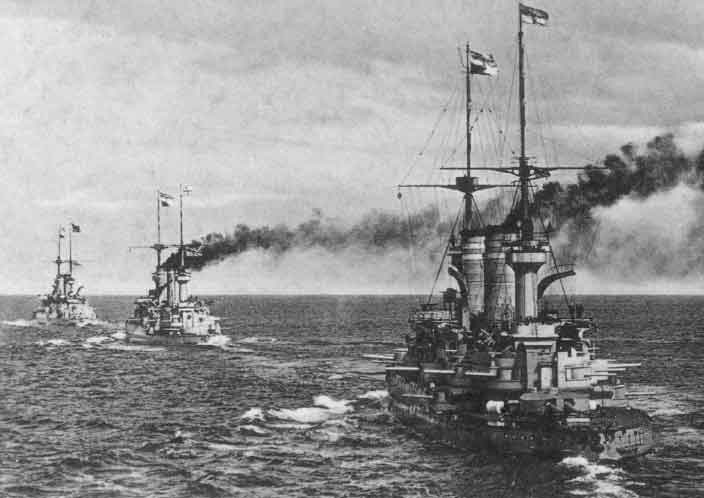
The I. Sqn at sea early in the twentieth century, with Kaiser Friedrich III in the lead, and two of her sisters astern. (Author’s collection)
Material Reserve
2 battleships
3 large cruisers
4 small cruisers
Of these ships, the intention was that at any given moment there should be:
In commission
9 battleships
2 large cruisers
6 small cruisers
In high-readiness reserve
4 battleships
4 coast defence ships
2 large cruisers
5 small cruisers
At two months’ notice
2 battleships or coast defence ships
To meet this objective, sufficient personnel would be made available to fully man all active capital ships and small cruisers (except for those serving overseas, where a crew-and-a-half per ship would be provided) and half the torpedo craft and other supporting vessels. For the reserve ships, half-crews would be provided (two-thirds for engineering personnel). Funding was also provided for, including the possibility of rolling-over of any underspend into the next fiscal year – a novelty in public finance.
As far as battleships were concerned, all this meant that five further ‘Additional Construction’ vessels had to be built to get this establishment up to strength, while two more large cruisers were needed (with three of the extant vessels already over-age). To ensure speedy implementation, the Emperor had decreed, even before the bill had been passed, that the next three projected battleships, Ersatz-König Wilhelm (= Kaiser Wilhelm der Große) and Battleships A and B (to be Kaiser Barbarossa and Kaiser Karl der Große), would all conform to the Kaiser Friedrich III design.
Prinz Heinrich
Large Cruiser A (to be Prinz Heinrich) was the first of the additional vessels in this category. A desire for economy resulted in a ship 1800t (17 per cent) smaller than the previous vessel, with half the main battery and two less secondary guns; she was also not sheathed and metalled, as intended for home service.1 As such, Prinz Heinrich was much criticised, although comparable to the two series of armoured cruisers initiated at the same time in France (Gueydon [9367t; two 194mm, eight 164mm; 21kts] and Bayan [for Russia – 7725t; two 8in [203mm], eight 6in [152mm]; 21kts), and not significantly inferior to the much bigger British Cressy, begun in 1898/99 (12,000t; two 9.2in [234mm], twelve 6in [152mm]; 21kts).
Prinz Heinrich also marked a significant technical advance over the preceding Fürst Bismarck, and in many ways represented the prototype for the next generation of German capital ships, her protection-conception marking a major departure from earlier practice, and which would be employed in German armoured ships down to the Second World War. The advent of the new Krupp cemented armour plate allowed more protective strength for a given thickness, the narrow waterline belt that had formed the basis of the side-armour of German ships since the Brandenburgs being now replaced by the concept of a belt (which still extended along the whole waterline) that extended up to the main deck amidships, either at the same thickness (as in Prinz Heinrich) or (as in many later ships) as a thinner upper belt (‘citadel’ in German terminology), joining up with the armour of the secondary battery, all being closed by bulkheads fore and aft.
Prinz Heinrich’s secondary battery was concentrated in the amidships area, in four turrets and six casemates. This not only protected the 15cm guns in the battery, but also the bases and ammunition-supply to the turreted 15cm weapons. More protection could also be applied to ammunition-supply routes for main battery. As compared with Fürst Bismarck, Prinz Heinrich’s belt was thus was half the thickness, but with much-enhanced survivability bestowed by the greatly increased armoured freeboard amidships. The new ship’s underwater hull-form was also altered, especially aft, with the upper-deck arrangement also cleaned up, and military masts replaced by poles. With the exception of the latter feature, much of Prinz Heinrich’s design – and especially her protective scheme – was carried over into the new Wittelsbach class of battleships, the ship also being the prototype for future large cruisers, including the earliest studies for Blücher (ii).

Prinz Heinrich as built. (Author’s collection)
Unlike Fürst Bismarck, Prinz Heinrich spent her life in home waters, of which only a few years were in front-line service. She was a gunnery training ship between 1908 and 1912, replacing the old purpose-built gunnery training vessel Mars, before paying off in 1912 on relief by Prinz Adalbert, remaining out of commission until the outbreak of the First World War.
The Wittelsbach Class
The first full post-Law naval programme (1899/1900) provided for the construction of Battleships C, D and E (to be Wittelsbach, Wettin and Zähringen), to bring the fleet up to legal strength. It was intended that the basic concept of the ships should not be changed from the Kaiser Friedrich IIIs, calls for a review of main battery calibre thus coming to nothing, as did suggestions that armour should be sacrificed to give an extra 0.75kts of speed, or that four 15cm should be replaced by a single 21cm turret on each beam.
On the other hand, ongoing dockyard infrastructure work now allowed an extra 5 metres length and 500t extra displacement; lessons learned and the impacts of new technology were also to be worked-in. As regards the latter, the new battleships followed Prinz Heinrich in realising the benefits of Krupp cemented armour, permitting the main belt to be thinned from 300mm in the previous class to 225mm, the weight saved allowing both a full-length waterline belt and the addition of an upper belt which, when combined with battery armour, meant that the whole side amidships was armoured to some degree. In addition, the edges of the armoured deck were sloped down to meet the bottom of the belt to protect against any shells that penetrated the belt, adopting a concept first applied in HMS Renown, begun in 1893. Armour thicknesses were generally similar to those of the contemporary British Formidable, London and Queen classes,2 German and British vessels having comparable protection through to the end of the pre-dreadnought era. French vessels of the République and Liberté classes had rather thicker belts (280mm vs. 225mm), but above this hull-sides were largely unprotected, with even more extensive ‘soft’ sides in the Russian Tsesarevich and Borodino class.
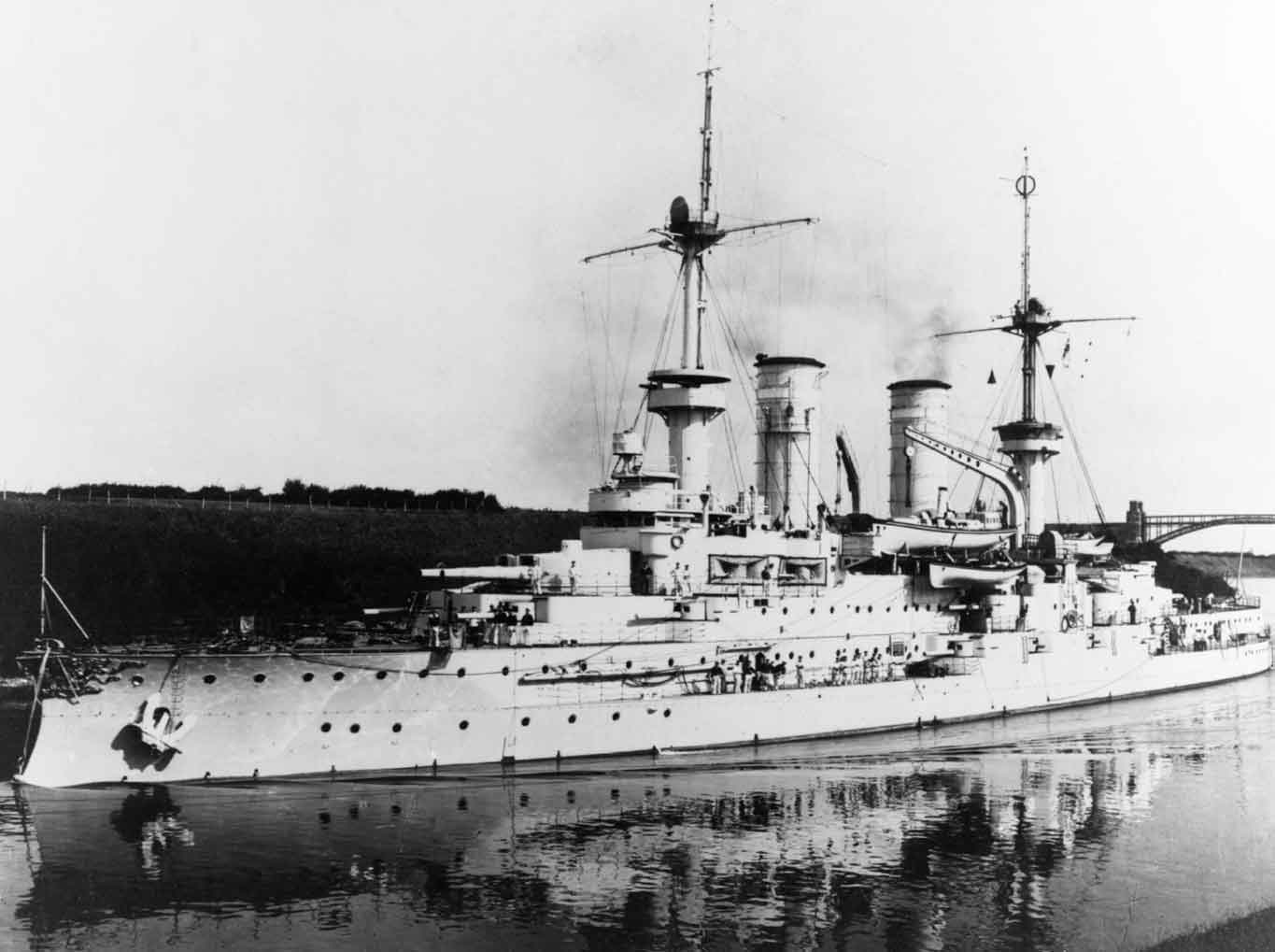
Wettin in the Kiel Canal in 1907. (NHHC NH 47897)

Three capital ships of the early twentieth-century German Navy at Wilhelmshaven: Kaiser Friedrich III, Prinz Heinrich and a member of the Wittelsbach class. (Author’s collection)
The Wittelsbach hull was made flush-decked, allowing the aft turret to be raised a deck level, and providing much-needed additional accommodation. The secondary battery was entirely rearranged and, although four of the secondary guns remained in upper-deck turrets, most of the 15cm guns were moved to the main deck battery, with consequences for working in bad weather. Mixed boilering was again employed, with engine power boosted by 5 per cent. Funnel-spacing was slightly different from the Kaiser Friedrich IIIs’ and the overall appearance of the ships was more ‘modern’ than the previous class. Compared with earlier ships, the trainable aft torpedo tube was not installed, although space was initially retained for potential retrofitting. Stern torpedo-fire was now provided by a sixth submerged tube, placed directly to the port of the rudder.
Funds for the first three of the class were formally approved by the Reichstag in the spring of 1899, with Battleships F and G (Schwaben and Mecklenburg) following the next year, to provide the two reserve vessels provided for in the Fleet Law. The five vessels were all-but-identical, and commissioned during 1902–4, providing a set of ten tactically coherent battleships.
The Prinz Adalbert Class
From the 1900 programme onwards, one large cruiser was authorised each year. The first of these was Large Cruiser B (to be Prinz Adalbert [ii]), ordered alongside the last two Wittelsbachs, the second the replacement for König Wilhelm in her cruiser guise (to be Friedrich Carl [ii]), ordered alongside the first two Braunschweig class battleships.
In hull dimensions and layout the pair were very similar to Prinz Heinrich, with the key exception of enhanced protection provided by joining the upper belt to the barbettes by oblique bulkheads and modifying and thickening the armour deck fore and aft. The machinery of the Prinz Adalberts was also similar to that of Prinz Heinrich, although some 10 per cent more powerful (the second of the new ships had 800ihp more than the first), giving up to 0.5 knot extra speed, in spite of a small increase in displacement.
However, the Prinz Adalberts looked very different from their prototype, with three half-cased funnels (although two were originally planned) and military masts of the same type installed in Fürst Bismarck, the later Kaiser Friedrich IIIs and the Wittelsbachs. Most importantly, however, while their secondary batteries were identical to that of Prinz Heinrich (albeit with the battery slightly shortened), the latter’s single 24cm main battery mountings were replaced by twin 21cm/40s, reverting to the calibre of the Victoria Louises (although with a new C/04 gun) as more suitable for cruiser use – particularly as the value of only two heavy guns on a ship was now coming into serious question. The 21cm calibre would be standard for German large cruisers until the leap to 28cm after Blücher. Otherwise, two additional 8.8cm guns were added to the tertiary battery (of a new 35-calibre C/01 model), in sponsons right aft.
Underwater, the propeller arrangements were modified in that the tubes for the wing shafts were shortened, faired more closely into the stern lines and made self-supporting. This change was incorporated into all later Second Reich capital ship classes for outer shafts.
Although Friedrich Carl commissioned within eighteen months of her launch, her elder sister was delayed by a lack of capacity at Kiel Dockyard, taking two-and-a-half years from launch to completion. Both ships spent most of their pre-war service in training and trials roles – indeed, Prinz Adalbert did not see any fleet service until August 1914.
The Second Fleet Law
While the 1898 Law had done much of what Tirpitz intended, once its totals had been reached, and the over-age ships replaced, the feast for the shipbuilding industry would be replaced by a famine – the gap in ship-authorisations after the last of the Sachsens would be mirrored in the acquisition of the modern replacements. Thus, after Oldenburg had been replaced in 1905, nothing could theoretically be ordered until Siegfried became over-age in 1912, after which the block-obsolescence of her sisters and halfsisters and the Brandenburgs would produce up to a dozen orders over five years. Such a build-drumbeat was clearly industrially unsustainable, as well as operationally undesirable – especially as the majority of the post-1912 ships would be coast defence vessels of a kind that were already of marginal use.
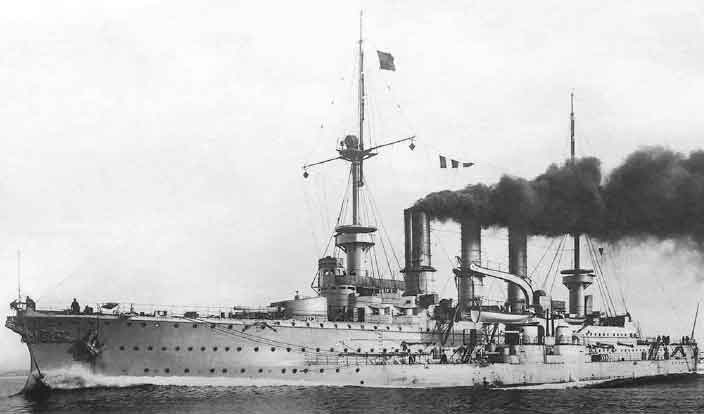
Prinz Adalbert (ii) on trials. (Author’s collection)
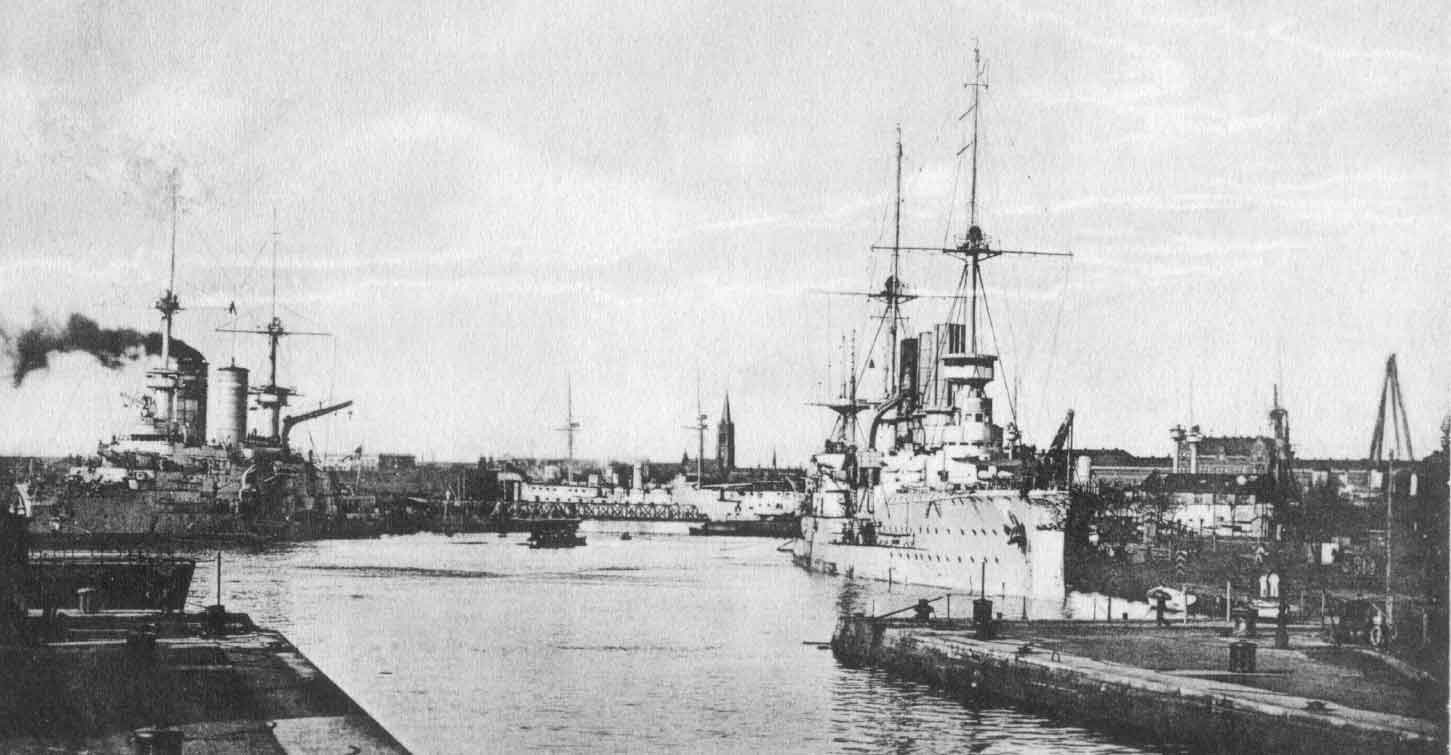
Wilhelmshaven in the early twentieth century, with a Wittelsbach class battleship on the left, a Prinz Adalbert class large cruiser on the right and the gunnery training ship Mars in dock in the background. (Author’s collection)
A further bill to expand the fleet to both increase its strength vis-à-vis the Royal Navy and fill the order-gap was therefore contemplated at an early stage, with a view to bringing it before the Reichstag in 1902. However, the detention and searching of German merchantmen by the Royal Navy during the Boer War provided an excuse for bringing the legislation forward, it becoming law on 14 June 1900, replacing the 1898 act. In accordance with it, the new fleet establishment was to be:
Home service – Active Battlefleet
1 fleet flagship
2 squadrons of eight battleships each
8 large cruisers as scouting vessels
24 small cruisers
Home service – Reserve Battlefleet (half in commission)
1 fleet flagship
2 squadrons of eight battleships each
Overseas service
3 large cruisers
10 small cruisers
Material reserve (half in commission; other half commissionable for manoeuvres)
4 battleships
3 large cruisers
4 small cruisers

A ship of the rebuilt Siegfried class at Kiel, with a Wittelsbach to the rear and a Gazelle class small cruiser to the left. (Author’s collection)
The two divisions of four coast defence ships each were removed from the fleet; however, the Law provided that the ships in question (the Siegfrieds and Odins) would be reclassified as battleships until replaced. While they were by no means comparable to the other ‘battleships’ of the fleet (although now being rebuilt to marginally increase their capability – see below), this change meant that when they became over-age, they would now be replaced by full-scale capital ships, not coastal vessels of much smaller size. Similarly, various old cruisers, gunboats and avisii were now all ‘small cruisers’ and to be replaced by proper general purpose cruising vessels.
The same requirements for the replacement of over-age ships were included, with the baseline fleet strength now enumerated as follows:

On the basis of this list, an extra ten battleships and two large cruisers needed to be built over the next five years, after which a programme of replacement construction would kick-in. The details of the latter, through to 1917, was set out in the law:
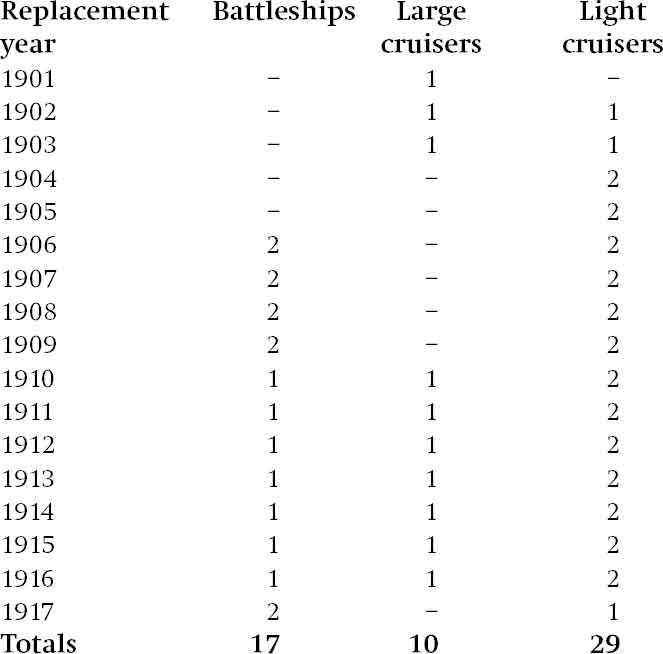
The Reconstruction of the Siegfried and Odin Classes
Beginning in 1899, the Siegfrieds and Odins underwent major reconstructions (formally funded under the 1901 to 1903 programmes), nominally intended to raise them the proper capital rank they were legally accorded under the 1900 law, although all it did was to give them a pair of additional 8.8cm guns, 45mm torpedo tubes, and an increased range by virtue of enlarged bunkers.
To achieve this, the ships were cut in two just in front of the engine room bulkhead, and a new mid-section added into the boiler-room, accommodating an expanded set of now-watertube boilers and the aforementioned additional bunkers. Reboilering had been in any case necessary in Hagen, which had suffered chronic boiler problems since her original completion; the boilers of Heimdall and Hildebrand had also given trouble. The lengthening of the compound-armoured ships left them with a belt of mixed materials and thicknesses, as the ‘gap’ was filled with Krupp armour which, because of its greater protective power, needed to be only three-quarters the thickness of the rest of the central main section of the belt.
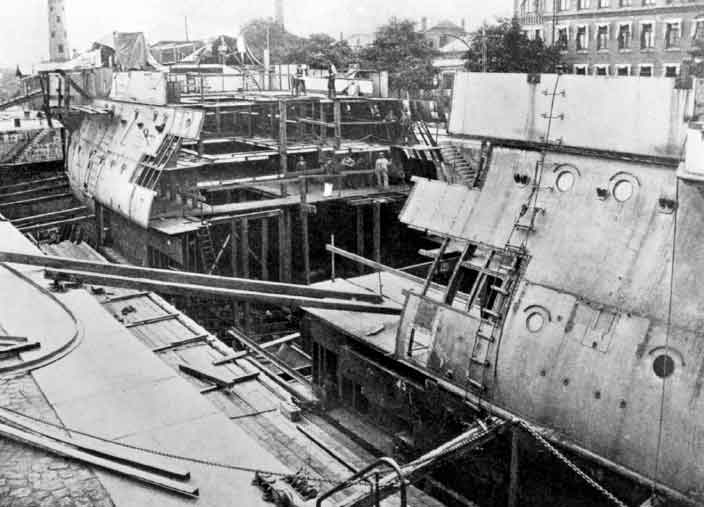
Heimdall dismantled and cut in two for lengthening at Kiel. (Dirk Nottelmann collection)

Hagen’s official plans as rebuilt. (Courtesy www.dreadnoughtproject.org)

Hagen as rebuilt, with short funnels. (Author’s collection)
As completed, the Odins continued to be distinguishable from their half-sisters. They both lacked the 8.8cm sponsons of the earlier ships, while Aegir retained her distinctive boat-cranes. Frithjof, Hagen and Heimdall also initially had funnels 1.2 metres lower than their sisters.
The Reconstruction of the Brandenburg Class
The Brandenburgs had been little altered since their completion, apart from the heightening of their funnels during 1894/95. Now, they were also extensively refitted between 1901 and 1905 (with funds voted under the 1902 to 1905 programmes), although not to the extent seen in the Siegfrieds and Odins. One proposal, to replace the midships turret with a battery of four 15cm guns (much as had been done in 1896–8 in the similarly-arranged French Amiral Baudins that had helped inspire them), was rejected for reasons of cost, and the main battery was merely equipped with new ammunition and telescopic sights. On the other hand, the boilers were re-tubed and an aft conning tower and a further pair of 10.5cm guns on the main deck installed. The trainable torpedo tubes were all removed except that at the stern, with a pair of new submerged tubes installed instead, a torpedo-room being worked-in forward of the fore magazines. In addition, the searchlights were moved from their platforms low down on the masts to the spotting-tops. This reflected a wide programme of rearranging searchlights within the fleet during the first decade of the twentieth century (see p 83).

Brandenburg following her reconstruction, shown with the modernised wireless rig installed around 1910. (Author’s collection)
The Passing of the Old Guard
With their replacements provided for in the 1899/1900 and 1900 programmes, and commissioned from 1903 onwards, the three large cruisers that had once been armoured frigates were all formally hulked in May 1904. König Wilhelm was stripped of all armament except for sixteen of her 8.8cm guns (two midships mountings being deleted) and had a large deckhouse added, to serve as a stationary training and accommodation ship for cadets, first at Kiel and then at Flensburg-Mürwik.
While König Wilhelm remained on the Navy List, Deutschland was stricken immediately, and was renamed Jupiter a few months later to allow her name to be taken by a new battleship. In 1907, she was temporarily used as a target, before being sold for scrap. Her sister Kaiser was renamed Uranus in 1905 and stricken the following year. Initially used as an accommodation ship at Mönkeberg, in 1908 she was moved to Flensburg-Mürwik to replace the explosion-damaged former corvette Blücher (i) in the torpedo school. Here, she first had her mainmast moved to the mizzen position, and was then largely housed-over and reduced to one funnel.
In this role, she had Württemberg as her tender, the latter having arrived in 1906 to become the torpedo firing ship, occasionally going to sea for exercises with other training and trials ships (see p 86). Württemberg had been the last of the Sachsens on active service, all of them having been paid off between February 1900 (Bayern) and Württemberg’s own decommissioning in September 1903. With the exception of Württemberg, the class were reduced to II. Reserve in 1906 and stricken in 1910, when two ships became targets and Baden a hulk for the mine-warfare school. While her sisters were all scrapped soon after the First World War, Baden followed them in 1920 into the role of target-hulk, and survived as such until the eve of the Second World War (cf. p 166, below).
In 1899 there was a further change in the organisation of the naval administration, the High Command being replaced by the Naval Staff (Admiralstab), as a result of the Emperor formally taking the overall command of the navy. The Naval Staff were directly responsible to him for, among other things, planning and implementing mobilisation, but it did not have the level of authority and influence of the Army Staff, the Navy Office remaining in the dominant player in the constellation of navy command authorities.
The Braunschweig Class
Discussions on the follow-on vessels to the Wittelsbachs (Battleships H, J, K, L and M) began in 1899, before the last ships of that class had even been begun.3 In particular, the question of main-battery calibre was raised once more, with FO I. Sqn pressing for a reversion to the 28cm gun, on the grounds of the greater destructive potential of the bigger shells (rather than greater armour-penetration or range). Naval consensus supported this change, but not for a further increase to the 30.5cm calibre widely used abroad. A key consideration was the desirability of being able to work and load the guns manually, as well as maintaining a rate of fire differential over potential opponents armed with larger guns.
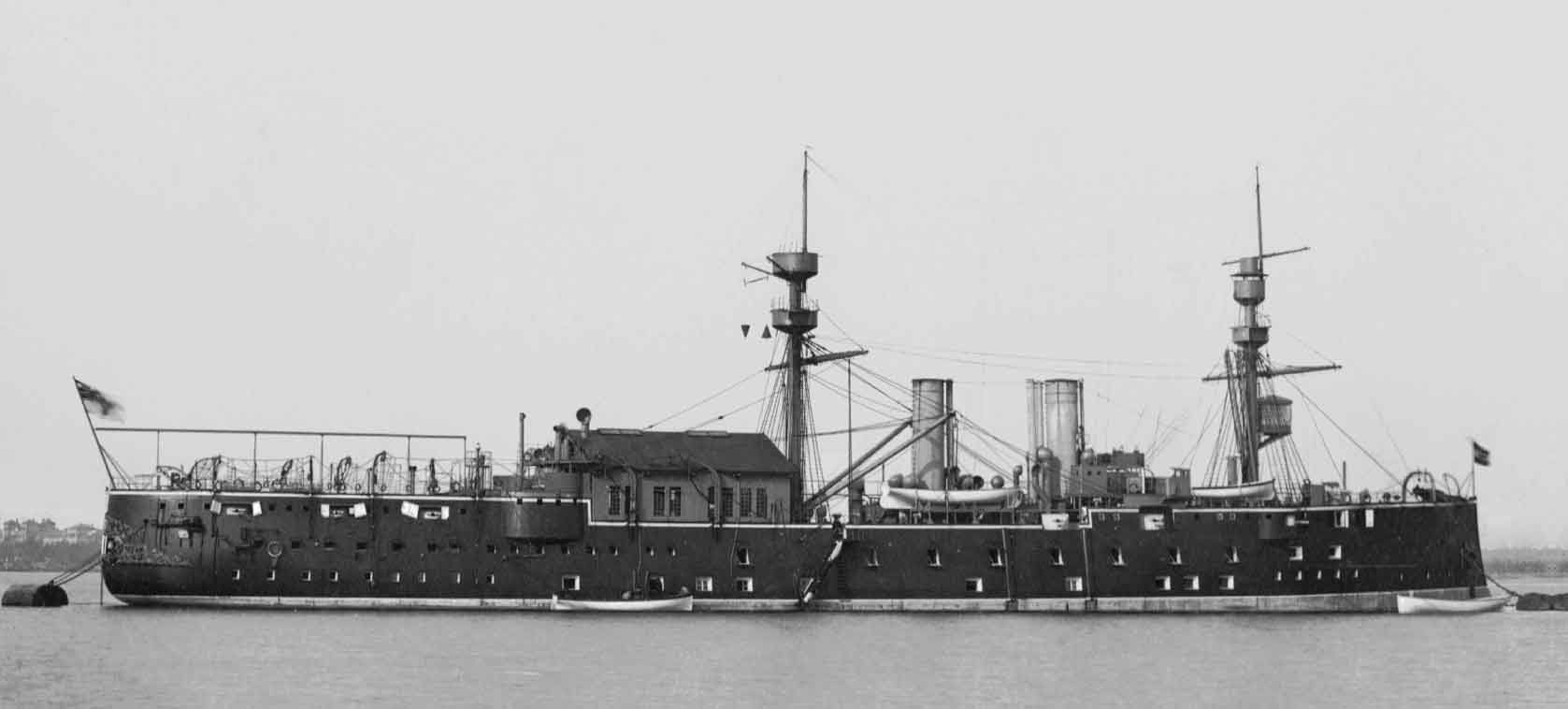
König Wilhelm as a stationary training ship; unlike other hulked ironclads, she remained a commissioned warship, although no longer going to sea. (Bundesmarineakademie)

The Germaniawerft at Kiel in the early autumn of 1904, showing Braunschweig completing fitting-out. (Author’s collection)
With the main-battery calibre now fixed at 28cm/40 (a new C/01 model), a series of sketches were produced with different secondary batteries. The first largely replicated the Wittelsbach arrangement, but there were concerns that the greater blast of the 28cm gun, as compared with the 24cm piece, would make the four forward 15cm guns (directly under the muzzles of the forward turret) untenable; there were also weight issues. Thus, a second sketch lowered the forward 28cm turret to upper deck level, with ten guns of the secondary armament in a main deck battery and the remainder in twin upper deck turrets. A third option raised the calibre of the secondary battery to 17cm, retaining the twin turrets, but reducing the number of main deck guns to six. The second option was initially favoured, with aspects of the protective scheme improved over that of the Wittelsbachs, particularly deepening the main belt to reduce the danger of it being submerged at full load, and to thicken the battery armour to 160mm. There were various other adjustments in thicknesses and coverage, but the basic conception remained as in the previous class.
The option of a heavier secondary battery continued to be debated, however, key issues in favour of going to 17cm including improvements in the protection of foreign vessels that made the 15cm gun less effective and the longer reach of the 17cm weapon; against were ranged such points as the complication of adding a new calibre to the naval inventory, a reduction in the number of guns, and a slower rate of fire. At length, it was decided to give the new ships a battery of twelve 17cm pieces, four in upper-deck turrets, the rest in a main-deck battery.
This trend towards a heavier secondary battery was to be found elsewhere at this time, in the American Connecticut, Vermont and Mississippi classes, which had 7in [178mm] weapons (as well as an 8in [203mm] intermediate battery). Such guns were, however, generally a qualified success as, although having greater hitting power than the ‘standard’ ~150mm weapon, their ammunition was at the upper limit of what could be conveniently hand-loaded and they were thus less effective weapons than had been anticipated.
There was also debate concerning raising the calibre of the tertiary anti-torpedo-boat guns from 8.8cm to 10.5cm. However, in this case the increase was rejected in view of the resultant halving of the battery and slowing its rate of fire: the 8.8cm gun would be retained until the abandonment of the tertiary battery during the First World War. Trials in 1897 had suggested that, for maximum effect, antitorpedo-boat guns should be distributed between the superstructure and embrasures at main-deck level, under the forecastle and quarterdeck, and amidships between two groups of 17cm guns, to allow the whole length of the ship to be covered. In spite of concerns at the viability of such mountings in a seaway, such main deck locations were a feature of German capital ships until the 1909 programme (Kaiser [ii] class and Seydlitz). As completed, the ships had twenty 8.8cm guns (of the new 35-calibre C/01 model), but the pair on the bridge abreast the conning tower were found to interfere too much with the operation of the ship, and were soon removed, in the case of the last ship Lothringen before entering service.
Throughout the design-process, the question of the maximum beam consistent with the entrance-locks of Wilhemshaven Dockyard was a key one; in the end a beam of 22.2 metres was agreed, along with a 1.5 metre increase in length to ensure appropriate lines. Given the constraints that infrastructure was placing on design, 1901 saw the beginning of a programme of upgrades at Wilhelmshaven, enlarging a slipway, building three new dry docks and constructing a new entrance lock (III), all to be complete by 1909.
A detail modification to the new battleship design was the substitution of three funnels for the previous two, on the grounds that the girth of funnels could obstruct views aft from the bridge, and that by distributing boiler-gases between three would result in a slimmer, less obstructive, profile. The funnels of the last ship, Lothringen, were 2.5m shorter than those of her sisters when completed, but raised to ‘normal’ height shortly afterwards. The boilers themselves were again a mixture of cylindrical and watertube units, with a discussion surrounding whether the latter should be of the Dürr or of the Schultz-Thorneycroft type: in the end, the latter prevailed, eight being installed alongside six cylindrical boilers.
Battleships H and J (to be Braunschweig and Elsaß) were ordered under the 1901 programme, with Battleships K and L (Preußen [ii] and Hessen) the following year, and Battleship M (Lothringen) under that for 1903, which also included the first vessel of a modified type (see below). Modifications continued even after the first ships had been ordered: as detailed calculations showed that they would come out 50t light, some minor armour enhancements were to be worked into the last three ships, while the planned 8.8cm guns in the midships main deck battery were replaced by an extra pair of 17cm guns, two of the lighter guns being moved to the superstructure.
The Roon Class
The large cruisers included in the 1902 and 1903 programmes were replacements for the last ex-armoured frigates, Kaiser and Deutschland. Ultimately named Roon and Yorck, they were a further modest modification of the Prinz Heinrich/Prinz Adalbert design, lengthened slightly amidships to accommodate two extra boilers, for an additional 2000ihp and another 0.5kt of speed. Displacement increased by around 500t, there also being a small increase in magazine capacity, plus the addition of extra pair of 8.8cm guns.

Hessen at the beginning of a career that would span six decades, showing the pair of 8.8cm guns abreast the conning-tower that were removed not long after completion. (Author’s collection)
While originally designed to have the same outline as the Prinz Adalberts, the additional boiler-power required a revision of uptake trunking, giving four funnels, much like their British and American armoured cruiser contemporaries. As in the previous class of large cruisers, the dockyard-built lead ship languished for over two years fitting-out, while her privately-built and later-started sister was completed half a year earlier. As completed, neither made their intended 22kts, the length-breadth ratio (dictated by dock-dimensions at Wilhelmshaven) being found inappropriate.
The 1903 Fleet Re-Organisation
A Cabinet order of 29 June 1903, and implemented on 22 September, re-organised the fleet on an underlying basis that would endure down to the end of the Imperial Navy. Under it, the Active Battlefleet, under a permanent CinC Fleet (initially double-hatted as Flag Officer I. Sqn), would comprise two squadrons of battleships, plus the Scouting Unit, the reorganisation being brought about by the parent ships of the Reserve Division becoming a permanent II. Sqn.
At the point of implementation, the I. Sqn comprised the Kaiser Friedrich IIIs, plus the first three Wittelsbachs, with the II. Sqn (actually only at this point of division-strength) made up of four Siegfrieds. The Scouting Unit comprised Prinz Heinrich (F), Victoria Louise and six small cruisers. However, the completion of new ships and major refits allowed the II. Sqn to be built up with fully-fledged battleships during 1904, with the position of Fleet CinC split from that of FO I. Sqn, although the fleet flagship remained tactically attached to that squadron.
The Deutschland Class
It was originally intended that the Braunschweig class should run to ten all-but-identical vessels. However, of the two battleships of the 1903 programme, while Battleship M (Lothringen) was indeed a member of that class, the second ship was built to a revised design. In addition to improvements in protection, the upper deck 17cm guns were moved from turrets into casemates, freeing-up space in the battery formerly occupied by turret supports and thus allowing the guns to be better arranged. The removal of the turrets also gave scope for adding an extra two 8.8cm guns and rearranging them, the forward four main-deck weapons also now being mounted in projecting ‘swallows’ nest’ embrasures.
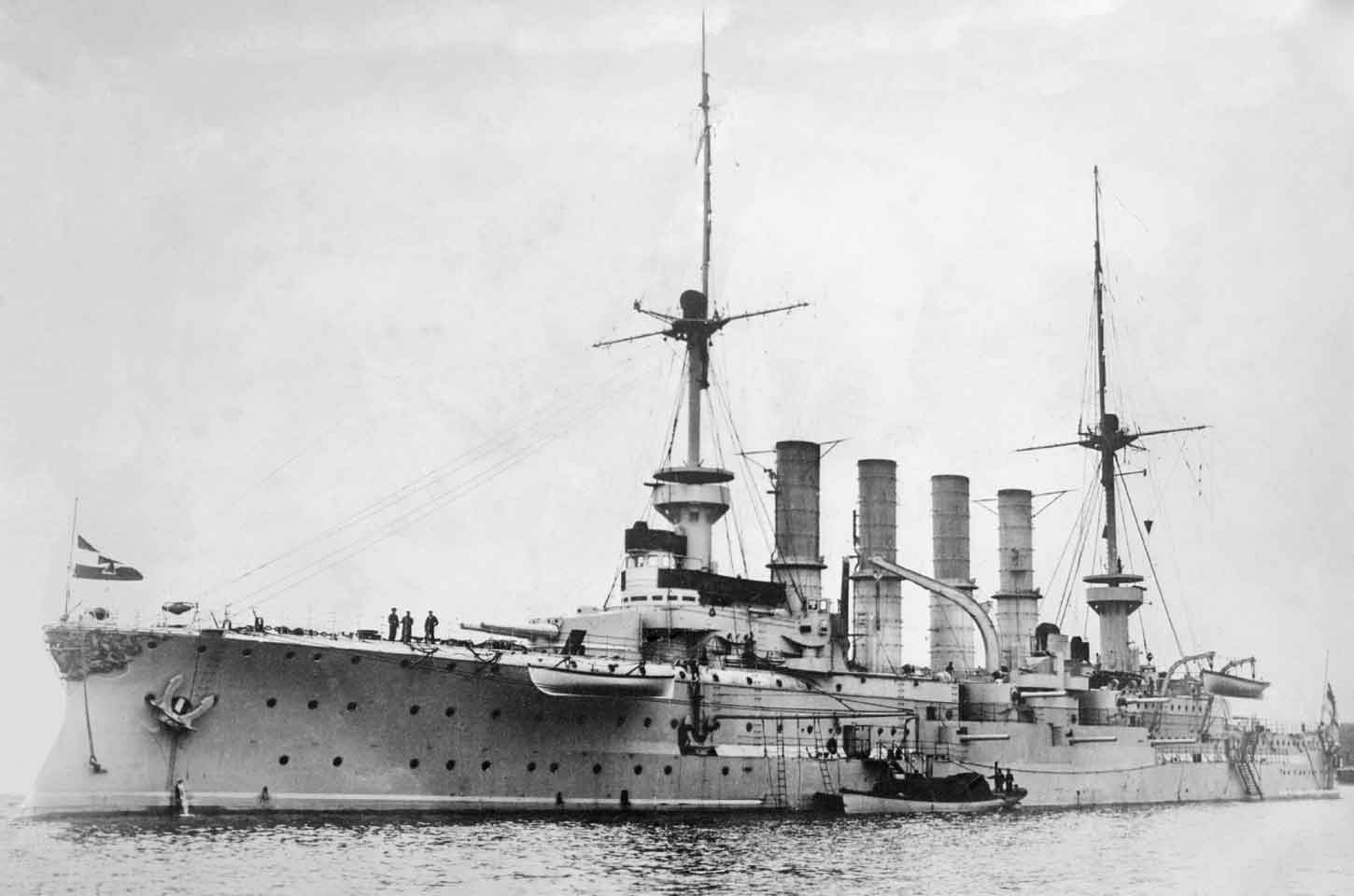
Roon soon after completion. (Bain News Service, via Library of Congress)
More space was also made available within the superstructure, which was used in Battleship N (Deutschland [ii]), designed as a fleet flagship, to provide the required extra accommodation. This was also the case in Battleship P (Hannover, 1904 programme), which was fitted as a squadron flagship. In the other three ships of the new class the aft superstructure was reduced in height by one deck, allowing all superstructure mounted 8.8cm guns to be placed in open mountings; Deutschland and Hannover, however, had to leave an after pair in embrasures. Other features of the revised design included only part-cased funnels and a stern-walk. Deutschland and Battleship O (Pommern [ii], 1904 programme) had an enlarged, two-storey, forward conning tower, but the remaining ships were given a new single-storey type that now omitted an integral fire-control position.
The 1904 ships, and the final two authorised under the 1905 programme (Battleships Q [Schleswig-Holstein] and R [Schlesien]), differed from Deutschland in having their cranes set slightly further aft, and a uniform set of twelve water-tube boilers rather than the mixed set used hitherto. Engine power was increased by 1000ihp, but with a slightly lower coal capacity and range. The boiler change also saved weight, allowing for a further enhancement of protection, the main belt and battery being thickened by 7 per cent each, and the fore and aft belt by 20 per cent. The upper deck over the battery also acquired 35mm armour. Deutschland relieved Kaiser Wilhelm II as flagship of the Active Battlefleet on completion and became flagship of the High Seas Fleet on its redesignation on 16 February 1907.
The Scharnhorst Class
The large cruisers (C and D, to be Gneisenau [ii] and Scharnhorst) that were funded alongside the Deutschland class ships of the 1904 and 1905 programmes were again a development of the line begun by Prinz Heinrich. However, this time an additional 2000t marked a significant growth in size, fighting power and speed, the General Department having requested they could if necessary substitute for a damaged battleship in the battle line. Thus, although of very similar appearance to the Roons, the main battery was doubled in size by replacing the turreted 15cm guns of previous classes with casemated 21cm weapons, the secondary battery being reduced to six guns on the main deck. The tertiary battery was further strengthened, being upgraded to battleship scale with two guns on each side of both the bow and the stern in main deck embrasures/sponsons. It was originally intended to have an additional pair on the bridge, abreast the conning tower, but following the experience in the Braunschweigs, these were deleted. In addition, the belt was thickened by 50 per cent to 150mm, firing trials on the Meppen range, using a mock-up of Prinz Heinrich’s side, having shown that the hitherto-used 100mm belt was insufficient to defeat medium calibre shells.

Deutschland (ii) with initial rig and funnel casings of equal height. (NHHC NH 64266)
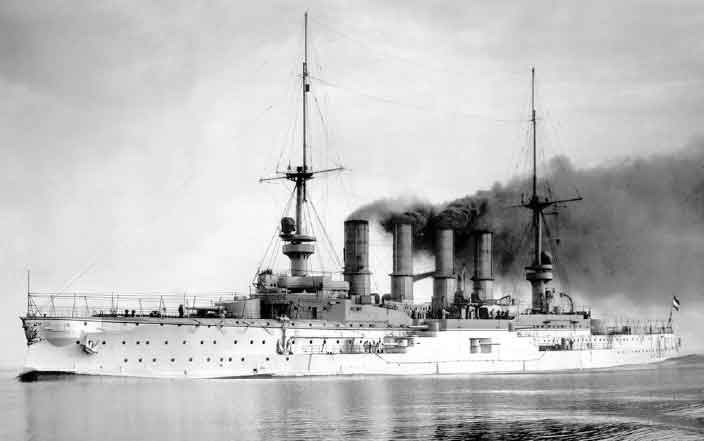
Scharnhorst on builders’ trials. (Author’s collection)
Another two boilers were added, horsepower being boosted by another 7000, giving Scharnhorst and Gneisenau and extra knot over the Roons (cf. p 66, above) – which they both exceeded comfortably on trials. They were thus the first German large cruisers to truly compare with their British and American counterparts although, as customary with German big ships, their main gun calibre was significantly smaller than the 9.2in [234mm] of the British Duke of Edinburgh/Warrior and Minotaur classes and the 10in [254mm] of the US Tennessee class.
After initially replacing Yorck as flagship of Scouting Ships in the High Seas Fleet, Scharnhorst sailed to the Far East on 1 April 1909 to relieve Fiirst Bismarck as flagship of the East Asiatic Squadron. On her return, Fiirst Bismarck was paid off for a major refit at Kiel (see below). Gneisenau left Germany to join her sister on 8 September 1910, both ships remaining in the east down to the outbreak of the First World War.
The Reconstruction of the Earlier Large Cruisers
Kaiserin Augusta was extensively refitted during 1903-7 (under the 1903 programme), although externally-visible changes were restricted to raised funnels and an enlarged bridge. However, when taken in hand from 1905 onwards, the Victoria Louises were much more extensively altered (Freya under the 1905 programme, Hertha and Victoria Louise under that for 1906, Hansa under that for 1907 and Vineta under that for 1909). Their superstructures and masts were cut down and the after pair of 15cm casemates removed to increase the space available for accommodation in their intended future role as seagoing training ships for cadets and boys. The bridgework was also altered, with Victoria Louise given a longer upper bridge than her sisters. In addition, all but the first into dock, Freya, were reboilered (Freya was so treated at her next refit, when she also had her new cranes fitted and a searchlight added to the maintop).
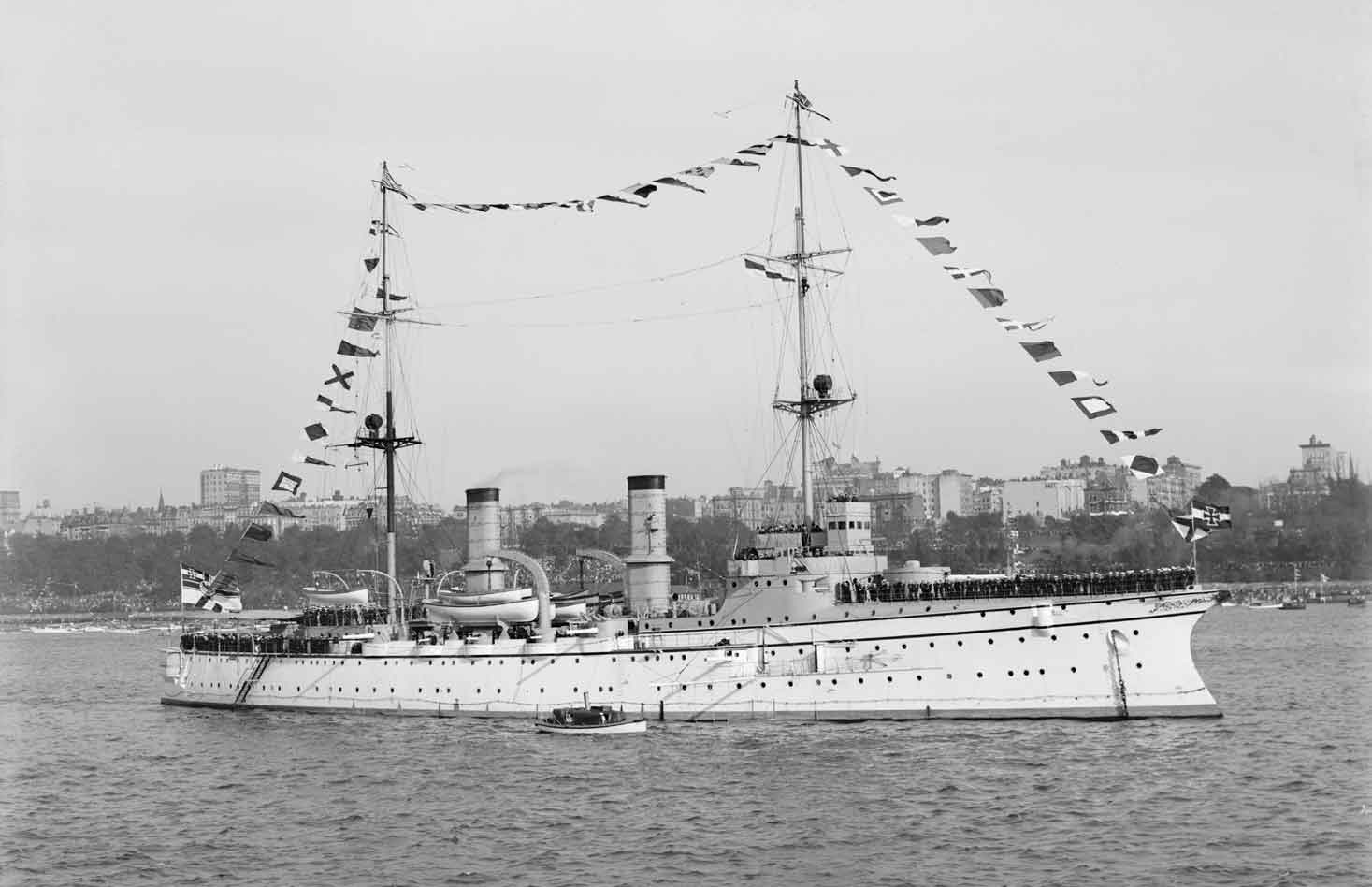
Hertha in the Hudson river in 1909, following reconstruction. She was reboilered and had her number of funnels reduced to two. (Detroit Publishing Co, via Library of Congress)
Following her return from the Far East in 1909, Fürst Bismarck was taken in hand at Kiel in 1910 for reconstruction, but the work seems not to have pursued with any urgency, and she had not recommissioned by the time the First World War broke out. The modifications were along the same lines as those made in the Victoria Louises, with the replacement of military masts with poles and a further reduction in topweight by cutting down some of the superstructure. However, in Fürst Bismarck’s case the machinery and armament were left essentially unchanged.4 The intent had been that when completed she would relieve Württemberg as the torpedo training ship at Flensburg, her torpedo rooms being enlarged accordingly.
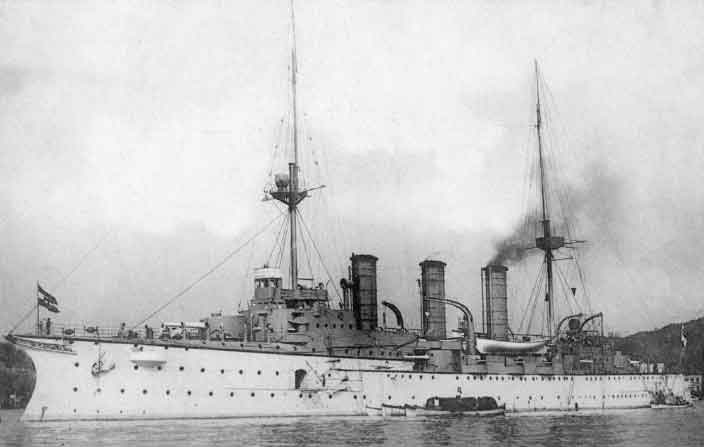
Freya after her first reconstruction, still retaining her original boilers and three funnels. (Author’s collection)
Prinz Heinrich was modestly rebuilt along similar lines at Kiel during 1914 – a September 1913 proposal that she be refitted as a training ship having been rejected. Her superstructure bulwarks were cut down and the masts modified, but little else was done. While neither Kaiserin Augusta, Fürst Bismarck nor Prinz Heinrich recommissioned until the outbreak of the First World War, the rebuilt Victoria Louises served worldwide in their training roles during the remaining years of peace (see p 86).

Freya after her second reconstruction; after this she was recognisable from her sisters in particular by new cranes and a searchlight at the maintop. (Author’s collection)
The Reconstruction of the Kaiser Friedrich III Class
As the Braunschweigs and Deutschlands came into service, it was possible to withdraw the Kaiser Friedrich IIIs for a reconstruction programme that been under consideration since 1905, work beginning under the 1908 programme. A major issue with the ships was that their belt was all but submerged at full load, and therefore a reduction in displacement was highly desirable. The approach taken was very similar to that employed in reconstructing the Victoria Louise class, the ships as rebuilt looking much alike, with superstructures cut down and military masts removed. The battleships had their the main-deck 15cm guns removed, while an additional pair of 8.8cm guns were added and whole anti-torpedo-boat battery rearranged, including shifting some guns to new main deck embrasures. This reflected the results of the 1897 anti-torpedo-boat trials that suggested that guns should be placed low down – although in reality they would have been largely useless in a seaway. Cranes were also replaced by derricks, except in Kaiser Barbarossa, the prototype reconstruction. The final ship of the class, Kaiser Karl der Große, was never taken in hand, presumably because of the changes that were occurring in the nature of the battleship when her time came for refit (see next chapter).
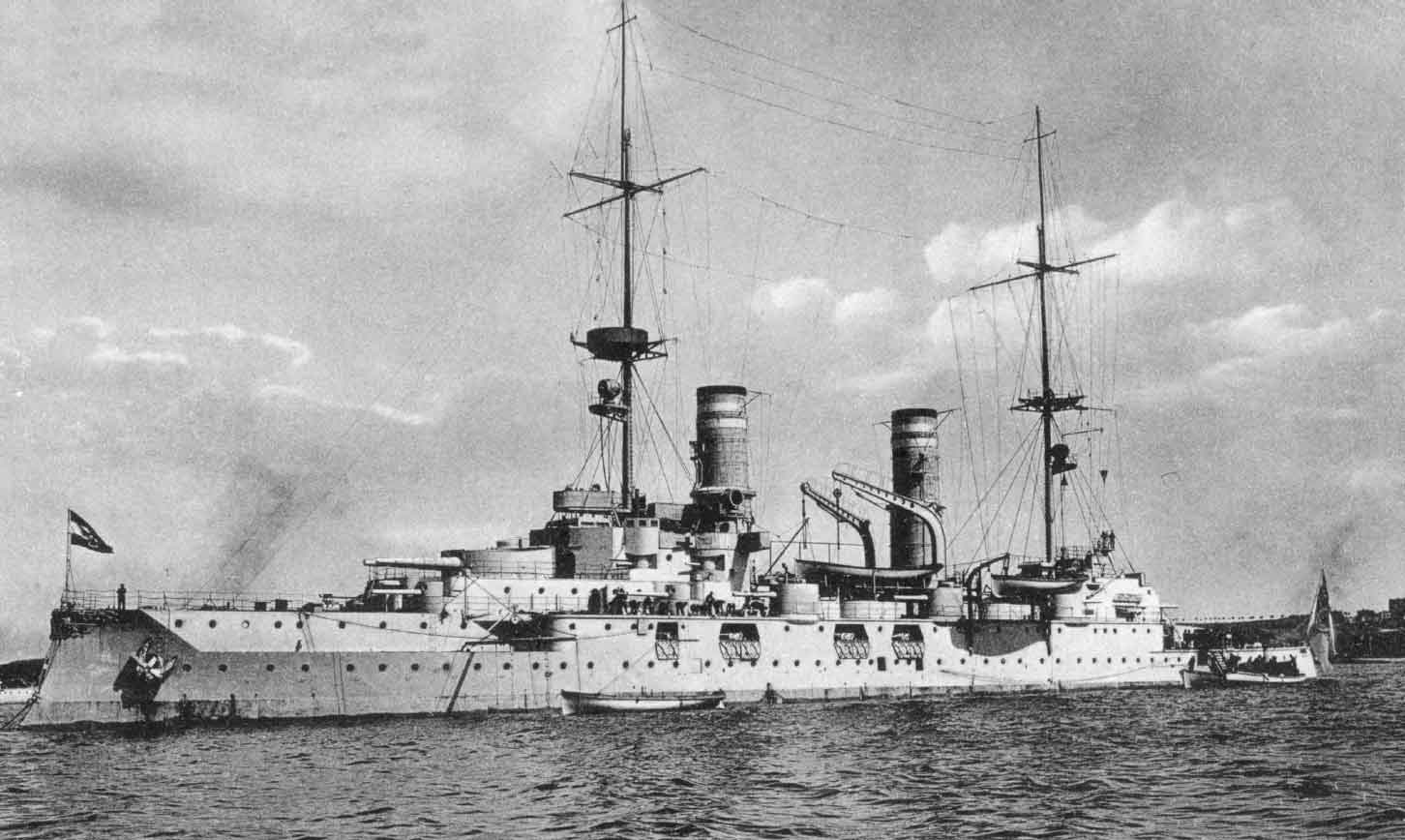
Kaiser Barbarossa as rebuilt, showing her greatly-reduced superstructure, cut-down funnel casings and the new 8.8cm battery added at main deck level; the first into dock, she was the only ship of the class to retain her goose-neck cranes. (Author’s collection)

Kaiser Wilhelm II (and Kaiser Friedrich III) retained their fatter forefunnels, even after reconstruction; she also displays the derricks stepped from the mainmast that replaced the ship’s former cranes in the last three ships to be rebuilt. (NHHC NH 46818)
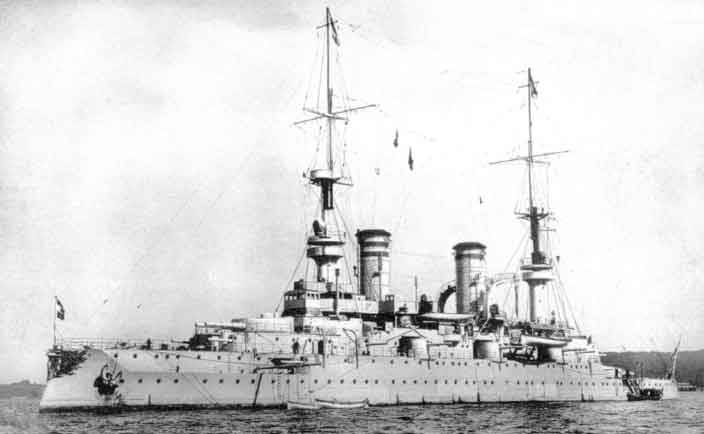
Kaiser Karl der Große was not rebuilt, although she received the aloft wireless refit common to all active ships at the time. (Author’s collection)
The 1906 Amendment to the 1900 Fleet Law
A First Amendment to the 1900 Fleet Law came into effect on 5 June 1906, increasing the overseas squadron to ten large cruisers, with two more such ships in reserve, giving a total of twenty. The additional six vessels required became Large Cruisers E to K (no I). As it turned out, these vessels would have little in common with previous ones and, indeed, 1906 and the following years would see capital ships changing almost beyond recognition.
1. Contrary to (e.g.) J C Taylor, German Warships of World War I (London: Ian Allan 1969), p 49, which alleges that she was designed for foreign service (which she never undertook).
2. The Canopus and Duncan classes had a belt a third thinner, but these vessels were intended as light/fast battleships, with protection sacrificed accordingly.
3. For an illustrated discussion of the evolution of the Braunschweig and Deutschland classes, see Nottelmann, ‘From Ironclads to Dreadnoughts: The Development of the German Navy 1864-1918, Part V: The Kaiser’s Navy’.
4. Gröner, German Warships 1815-1945, 1, p 49 states that the after pair of 15cm turrets were removed, but photographs taken after the refit show them still in place.